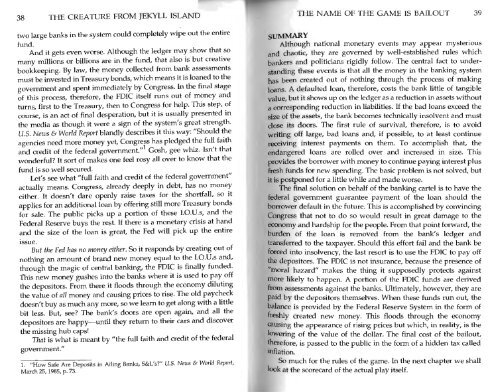You also want an ePaper? Increase the reach of your titles
YUMPU automatically turns print PDFs into web optimized ePapers that Google loves.
38 THE CREATURE FROM JEKYLL ISLAND THE NAME OF THE GAME IS BAILOUT 39<br />
two large banks in the system could completely wipe out the entire<br />
fund.<br />
And it gets even worse. Although the ledger may show that so<br />
many millions or billions are in the fund, that also is but creative<br />
bookkeeping. By law, the money collected from bank assessments<br />
must be invested in Treasury bonds, which means it is loaned to the<br />
government and spent immediately by Congress. In the final stage<br />
of this process, therefore, the FDIC itself runs out of money and<br />
turns, first to the Treasury, then to Congress for help. This step, of<br />
course, is an act of final desperation, but it is usually presented in<br />
the media as though it were a sign of the system's great strength.<br />
U.S. News & World Report blandly describes it this way: "Should the<br />
agencies need more money yet, Congress has pledged the full faith<br />
and credit of the federal government/' 1<br />
Gosh, gee whiz. Isn't that<br />
wonderful? It sort of makes one feel rosy all over to know that the<br />
fund is so well secured.<br />
Let's see what "full faith and credit of the federal government"<br />
actually means. Congress, already deeply in debt, has no money<br />
either. It doesn't dare openly raise taxes for the shortfall, so it<br />
applies for an additional loan by offering still more Treasury bonds<br />
for sale. The public picks up a portion of these I.O.U.s, and the<br />
Federal Reserve buys the rest. If there is a monetary crisis at hand<br />
and the size of the loan is<br />
issue.<br />
great, the Fed will pick up the entire<br />
But the Fed has no money either. So it responds by creating out of<br />
nothing an amount of brand new money equal to the I.O.U.s and,<br />
through the magic of central banking, the FDIC is finally funded.<br />
This new money gushes into the banks where it is used to pay off<br />
the depositors. From there it floods through the economy diluting<br />
the value of all money and causing prices to rise. The old paycheck<br />
doesn't buy as much any more, so we learn to get along with a little<br />
bit less. But, see? The bank's doors are open again, and all the<br />
depositors are happy—until they return to their cars and discover<br />
the missing hub caps!<br />
That is what is meant by "the full faith and credit of the federal<br />
government."<br />
1. "How Safe Are Deposits in Ailing Banks, S&L's?" U.S. News & World Report,<br />
March 25, 1985, p. 73.<br />
SUMMARY<br />
Although national monetary events may appear mysterious<br />
and chaotic, they are governed by well-established rules which<br />
bankers and politicians rigidly follow. The central fact to understanding<br />
these events is that all the money in the banking system<br />
has been created out of nothing through the process of making<br />
loans. A defaulted loan, therefore, costs the bank little<br />
of tangible<br />
value, but it shows up on the ledger as a reduction in assets without<br />
a corresponding reduction in liabilities. If the bad loans exceed the<br />
size of the assets, the bank becomes technically insolvent and must<br />
close its doors. The first rule of survival, therefore, is to avoid<br />
writing off large, bad loans and, if possible, to at least continue<br />
receiving interest payments on them. To accomplish that, the<br />
endangered loans are rolled over and increased in size. This<br />
provides the borrower with money to continue paying interest plus<br />
fresh funds for new spending. The basic problem is not solved, but<br />
it is postponed for a little while and made worse.<br />
The final solution on behalf of the banking cartel is to have the<br />
federal government guarantee payment of the loan should the<br />
borrower default in the future. This is accomplished by convincing<br />
Congress that not to do so would result in great damage to the<br />
economy and hardship for the people. From that point forward, the<br />
burden of the loan is removed from the bank's ledger and<br />
transferred to the taxpayer. Should this effort fail and the bank be<br />
forced into insolvency, the last resort is to use the FDIC to pay off<br />
the depositors. The FDIC is not insurance, because the presence of<br />
"moral hazard" makes the thing it supposedly protects against<br />
more likely to happen. A portion of the FDIC funds are derived<br />
from assessments against the banks. Ultimately, however, they are<br />
paid by the depositors themselves. When these funds run out, the<br />
balance is provided by the Federal Reserve System in the form of<br />
freshly created new money. This floods through the economy<br />
causing the appearance of rising prices but which, in reality, is the<br />
lowering of the value of the dollar. The final cost of the bailout,<br />
therefore, is passed to the public in the form of a hidden tax called<br />
inflation.<br />
So much for the rules of the game. In the next chapter we shall<br />
look at the scorecard of the actual play itself.


